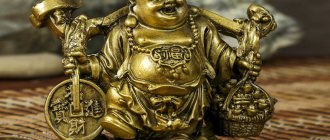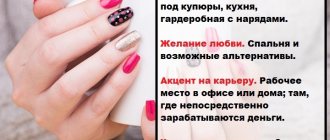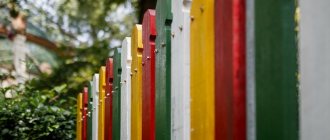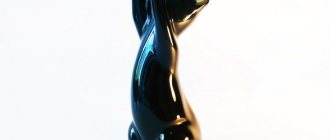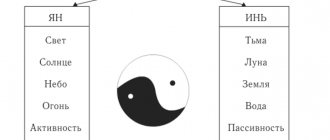In the human body, the energy obtained from yin and yang foods is converted into internal energy, which we need for thinking, growth, movement, reproduction, digestion and other needs.
In medical practice, for the treatment of diseases, the use of traditions and schools with holistic and harmonious treatment systems in combination with modern scientific achievements is very effective. Schools of traditional medicine include oriental medicine with a table of yin and yang products, the views of ancient healers (for example, Hippocrates) and some others. Even though they are based on different philosophies, they have a lot in common.
History of the symbol
It is assumed that initially the image of “yin” and “yang” imitated the appearance of a mountain, which is illuminated on one side, while the other half is in shadow.
This state of affairs cannot continue forever: the Sun moves along a trajectory - accordingly, the two sides of the mountain change their colors. It was implied that everything in the world is cyclical. The ancient Chinese borrowed the image from the Buddhists. The exact date is unknown, but historians say that it happened in the 1st-3rd centuries AD. It was then that the concept of “mandala” arose in the teachings of Taoism - the feminine and masculine principles. The pictures depicting their interaction were first drawn in the form of fish.
It’s interesting, but over time in the Celestial Empire other meanings were assigned to the sign: for example, the struggle between evil and good, the ratio of harmful and beneficial - everything that is at diametrically opposite poles. Although researchers argue that the symbol demonstrates precisely natural opposites, and not moral or ethical ones.
Activation of the talisman
In recent years, it has become very fashionable to wear this sign and get a tattoo with this symbol.
However, for the amulet to be useful, its attitude towards the owner is important.
Without preliminary preparation and activation, it will not work. By performing a certain ritual, you can get a powerful assistant. In terms of capabilities, it will not be inferior to other similar amulets.
Energy charging
Every object existing in the world has its own unique charge. Some are associated with a minus sign, while others are associated with a plus sign. If the product was purchased in an esoteric store, it must first be cleansed of the energy of the people in whose hands it was.
Charging the amulet:
It should be held under the tap for a couple of minutes or dipped in a salt solution. Then you need to charge the talisman with the energy of your element. There are 4 of them: fire, water, air and earth.
Depending on your zodiac sign, the following principles must be observed:
- Fire signs (Aries, Leo, Sagittarius) must carry the amulet through the candle flame 7 times.
- Water signs (Pisces, Cancer, Scorpio) do the same with a glass of water.
- Air signs (Gemini, Libra and Aquarius) can fumigate the amulet with their favorite incense.
- Earth signs (Taurus, Virgo, Capricorn) can hold an object in the ground.
Emotional
It is important to choose the right day to perform the ritual.
Next, follow these steps:
Sit at the table and hold the talisman tightly in your hands. Sit in this position for about 10 minutes and constantly think about the good: your favorite people or places. It is useful to share happy moments in life so that in the future he will attract only positive situations. Then pack the item in a piece of fabric, but not black. Hide it in a secluded place for a week. During this time, constantly talk to the talisman, share your most intimate thoughts with him.
It is important that it absorbs the energy of its future owner. After completing all the rituals, keep the talisman with you. Like any piece of jewelry, the amulet needs to be looked after: cleaned and wiped in a timely manner. To maintain energy, it is important to talk to the amulet periodically.
The image of the sign can be found anywhere: on clothing, decorative elements, jewelry. When bringing this symbol into your home, you must know its meaning and the energy it carries. When the feminine and masculine principles begin to coexist in a person, his biofield becomes invulnerable. A kind of wall appears in the path of everything evil and bad.
Evaluation of Yin and Yang indicators. Normal 1.1 -1.2 µA
According to the theory of the East, all human organs are divided into main (hollow and dense) zhang fu and accessory organs.
The main dense organs and, accordingly, meridians are as follows: lungs - meridian; spleen/pancreas – IV meridian; heart – V meridian; kidneys – VIII meridian; pericardium – IX; liver – XII meridian. They all belong to the “YIN” system and are capable of preserving, protecting, creating, i.e. accumulate energy. Accessory organs are hollow. Accordingly, the meridians are as follows - large intestine - II meridian; stomach – III meridian; small intestine – VI meridian; bladder – VII meridian; triple heater – X meridian; gallbladder – XI meridian. These organs – meridians – belong to the “YAN” system. They perceive food, crush it, absorb nutrients, secrete waste, etc. Metabolism or metabolism requires that all nutrients be oxidized, “burned in a flame of oxygen,” in order to turn into products necessary for the body’s functioning and release energy.
Metabolism consists of the metabolism of fats, proteins and carbohydrates, water and mineral metabolism, the function of absorption of vitamins, microelements and other useful substances.
The end products are water and carbon dioxide, which must be released from the body. Physical activity, increased body temperature, stress, and psycho-emotional stress increase metabolic processes, which leads to additional oxygen consumption. At the same time, the formation of CO2 increases, this leads to an increase in pulmonary ventilation.
Metabolism is sharply disrupted in diseases of the endocrine system, in case of dysfunction of absorption in the small intestine, in case of dysfunction of the liver, kidneys, etc. Metabolism is characterized by two stages: assimilation (anabolism) - synthesis, and dissimilation (catabolism) - decay
Taking into account the concept of "YIN - YANG", these two processes must be balanced and fluctuate within certain limits
At the bottom of the diagnostic chart there are indicators of the yin/yang ratio. “YIN” is the sum of the electrical conductivity of all “Yin” meridians (lungs; spleen/pancreas; heart; kidneys; pericardium; liver). “YAN” is the sum of the electrical conductivity of all “Yang” meridians (large intestine, small intestine, stomach, bladder, triple heater, gall bladder).
The YIN/YANG ratio characterizes the stage of metabolism, which is necessary for the doctor to understand. In a balanced body in a practically healthy person, the yin/yang ratio should be in the range of 1.1 - 1.2 µA
The predominance of “yin” indicators is regarded as assimilation (anabolism), i.e. slowdown of metabolic processes, their inertia. These indicators are typical for patients with sluggish chronic processes with physical inactivity, i.e. the predominance of parasympathetic regulation of the autonomic nervous system (overexcitation of the n.vagus, which provides innervation to the heart, lungs, digestive system, as well as the genitourinary organs and rectum).
The predominance of “yang” indicators is regarded as dissimilation (catabolism), i.e. acceleration of metabolic processes, increased decay, impaired absorption, removal of some useful substances from the body along with toxins and free radicals. This condition is characteristic of the sympathetic regulation of the autonomic nervous system (sympathetic-adrenal system and hypothalamus) (see part VI - level of autonomic regulation).
The metabolic rate is a fairly reliable criterion for assessing the functional state of the body, which is important for carrying out therapeutic as well as preventive procedures.
A man has too much Yin energy
1. Passivity. It is not surprising that a man with predominant Yin energy will be overweight and have little income. After all, the activity and determination inherent in Yang energy will be blocked by the passivity and inertia of Yin energy.
2. Softness. The principle of fluidity and flexibility inherent in Yin energy will lead to the fact that a man in whom this energy dominates will try to avoid sharp corners, not enter into conflicts, and make compromises.
3. Inability to give. Such a man does not feel like a breadwinner. He has absolutely no desire to give something, but he will not refuse to receive something without making any effort.
Balance is a very fragile thing. Achieving energy balance and finding harmony can be difficult. But not easy does not mean impossible. We will tell you about ways to harmonize personality in our next article in the “Yin-Yang” section.
Ancient China with its philosophy attracts with the traditions of Feng Shui. They are still shrouded in mystery, although they are based on simple observation. The ancient Chinese symbol “Yin-Yang” is now known to almost everyone: a two-color circle, the halves are separated by a wavy line and resemble two commas that cover each other.
Products to replenish Yang energy
- Mutton
- Wild meat
- Additives: ginger, cinnamon, other spices
- Eggs
- Sea cucumbers
- Shrimps
- Nuts (walnuts, cashews, pine)
- Pumpkin
Important
- Limit the amount of fruit in your diet. Eat fruits in heat-treated form.
- Eat warm food.
Remedies that will add Yang energy
| ANIMAL ORIGIN | MEDICINAL SUBSTANCES |
| CORDICEPS | MONSKING OF CARSHIMEL |
| PANTS | Short-horned horned weed |
| SEA HORSES | CISTANCHE DESERT |
| GENITAL ORGANS OF ANIMALS | CHINESE DODDLE |
| Eucommia elm |
The best medicine for replenishing Yang energy is Gui Fu Di Huang Wan PILLS.
Author of the article
Tamara Khestanova
Founder of medical medicine, reflexologist, nutritionist, hirudotherapist, author of the “invisible needle” weight loss method.
Did you like the article? Share with friends on social networks
Chinese medicine and Yin and Yang energies
The concept of Yin and Yang has been applied to many industries with excellent results. One such industry is Chinese traditional medicine. The harmony of energy flows and the functioning of the internal organs and parts of the body is the reason for the optimal health achieved. In general, the right combination of negative and positive should achieve physical balance in the pursuit of good health and longevity. Therefore, the study and practice of Yin and Yang will bring many benefits to the perfect existence of any organism. In this concept, the ability to harmonize and use everything in abundance is learned and practiced.
Using this concept, disease appears as a cause of disturbance in the harmony of the body, which is caused by emotions, heat, cold or other factors, thereby making a diagnosis and prescribing treatment, the primary intention is to restore balance. Even basic elements like water and fire have a Yin and Yang connection. The reason they cannot work without each other is the origin of these forces. A lack or excess of these forces - and the result is an imbalance of Yin and Yang. Light and darkness also relate to each other. Each force complements each other, but none of them tries to surpass the other - this is the perfect balance of Yin and Yang.
Share link:
Click on a star to rate it!
Submit rating
Average rating / 5. Vote count:
Food is also divided into Yin and Yang
Macrobiotics tells about this. Therefore, depending on what you eat, it depends on how energetic and good you feel, and as a result, how confident you are. Since most foods belong to the yin element, it is necessary to add yang foods to your diet that contribute to your vital functions.
If you apply the balance of Yin and Yang in life, you will have more strength, and harmony will always reign in your home. But do not forget about other energies penetrating the room. A Feng Shui specialist will help you calculate, draw up an energy map of the room and give recommendations for protection from negative energies.
Beneficial properties of ginger tea
Ginger tea helps and warms up colds, is used to boost immunity, has wonderful anti-inflammatory properties, parasitic properties, helps stop the development of atherosclerosis, thins the blood, promotes the outflow of mucus from the body, normalizes and improves metabolism, stimulates brain function, strengthens memory, relieves the symptom of nausea, burns excess weight, promoting weight loss. In addition, ginger tea with lemon improves skin conditions, and ginger tea with honey is useful for diseases of the gastrointestinal tract and liver.
YANG energy
In the West, the spice “ginger root” is viewed from a practical point of view - it is useful, it tastes good, it helps. In the East, ginger is treated differently. It is believed that ginger restores the lack of YANG energy in the body.
YANG energy in Traditional Chinese Medicine is considered a masculine energy that nourishes and supports the functioning of all hollow organs. In addition, YANG energy is considered to be giving energy, the energy of strength, positivity, day and light (solar energy). Its deficiency manifests itself in a general loss of strength, constant chronic, sluggish colds, drowsiness, reluctance to engage in any physical activity, mental fatigue, and sweating. There is coldness in the limbs and body, menstrual pain is eliminated, which is helped by warmth, weak pulse, extinction of libido, morning back pain, exhaustion.
Making ginger tea to restore YANG energy
In the East, they drink special ginger tea to restore yang energy.
The best ginger tea for restoring YANG energy, for daily use, is prepared as follows:
What you need for tea:
- Live ginger root
- Lemon
- Black tea loose leaf
- Green tea loose leaf
- Honey
In addition, prepare:
1.5 liter thermos, fine grater, boil 2 liters of water.
Preparing ginger tea:
Take a thermos, pour 0.5 teaspoon of green tea into it, then 0.25 teaspoon of black tea. Fill about 6-10 cm with boiling water.
Then take 5 cm of ginger root, peel it and grate it. Throw grated ginger and juice into a thermos. Take a lemon, cut off 2 rings of 0.5 cm each, chop finely and also throw it into a thermos. Then slowly add water (boiling water), filling the thermos ¾ full. Place the lid on the thermos, but do not screw it on. After 5-7 minutes, open the thermos again and add 4-5 teaspoons of honey (as you like) to the ginger tea with lemon. Mix the ginger tea well with a spoon and fill the thermos with boiling water until the end. Close and leave for 3-4 hours. After this, ginger tea to restore YANG energy is ready.
Tea with ginger invigorates, and therefore is drunk 2-3 times a day until 16.00 in the evening.
Do not forget that preparing ginger tea to restore YANG energy should be done daily, but not more than 20 days. Then a break of 1-1.5 months is taken. This tea is good for all colds, weight loss and boosting immunity.
Content
- 1 Linguistic aspects 1.1 Characters
- 1.2 Pronunciations and etymologies
- 1.3 Values
- 1.4 Toponymy
- 1.5 Borrowings
- 2.1 Chinese gender roles
- 4.1 I Ching
- 6.1 Footnotes
Attraction
Since the masculine and feminine principles are present in each of us in different proportions, we initially look for what we lack. If “yin” dominates, we are drawn to a partner with a strong “yang”, and vice versa
Until a person balances his two halves, only people of a certain type of character, lifestyle, and even appearance will pay attention to him. Look at your partner and you will see what you personally lack
If a representative of the fair half of humanity makes friends with the “woman” within herself, then she becomes wiser. The girl understands that giving in does not mean admitting defeat, and eternal resistance is not a victory. A man, having established contact with his “yang,” becomes convinced that the source of courage is not in violence, but in the open expression of feelings. Awakening soft qualities in representatives of the stronger sex and hard ones in their ladies is the key to harmonious relationships, eternal love and affection. When the feminine and masculine are reversed, we gain a better understanding of the opposite sex.
Energy is CRAP
And now pay attention: I will introduce you to a new type of energy!
Meet me: I want to introduce you to yours, and my old friend, the energy CRAP (if the word “Crap” is offensive to you, offer other options, I will be happy to consider them).
Here are the identifying signs of “Crap” energy:
It’s impossible to enjoy what is, well, you don’t like what’s happening, and that’s all. I can’t do something - well, of course, I’m a girl, and I have YIN energy. I can't. I'm waiting for the prince who will come and decide everything
And it doesn’t matter that I hang out where there have never been princes. He will take me and find me
And I watched a film about it. And it’s completely nonsense that I’ve been waiting for him for many years. I'm YIN! I don’t really know what I want either, but suddenly it will come and be decided, just as I need it. At the same time, I don’t really know what I need. And the way it is being solved does not suit me. I do not know how. There’s really no one to ask, I live in the steppe, desert, tundra. There is no Internet, people on earth have disappeared. What you want to do has never been done before. I only ask advice from people who have never done what I’m asking them about, and know a lot about ways in which it won’t work.
Girls, my dears, this is not YIN and YANG, this is Crap. Just like a strange, incomprehensible desire to recognize only the YIN energy in oneself and completely deny the YANG. Without inhalation there is no exhalation. So these two energies are interconnected. Your task is to recognize them and apply them in life.
If you want to get married and preferably to a worthy man, this is YANG (male) energy. Energy of purpose, intentions. Yes, you want and you clearly know what. Set a goal. You study the strategy for achieving it, plan, and act. BUT at the same time you are doing women's practices. As they say, get grounded. Learn to be so gentle when you need it.
If YIN, then you enjoy and accept what is, and not in a forced way, but in reality you feel great about everything. You well. And this also needs to be learned. You don't need to be afraid of the power that you have. And the pressure that you can show if necessary. At the same time, it is very useful to be able to do this softly, very clearly steering the situation in the direction you need. Set your boundaries in a timely manner, say in a timely manner that something upsets you or you don’t like. Calmly explain what you need without causing yourself and the situation to explode.
Now please tell me about what life is like for a woman who has only feminine energy
? She feels good, really feels good with and without her husband, she is not looking for anything or anyone. This is when you don't try to be happy, but really happy.
Well, what if you still want to do, change, improve something? Think about whether you already have a goal, do you have the male Yang energy to achieve it? Yes, in order to set and achieve goals, even very feminine ones, you need YANG energy. Accept it. And be happy about the qualities that help you get what you want. Set yourself a goal, in addition to this, to learn new ways of achieving goals - female ones.
If you are foaming at the mouth to prove that you are YIN and don't need to achieve goals, are you actually enjoying what you have? By the way, proving something with foam at the mouth is also Yang energy, and at a fairly low level.
Do you know how to get together and do something to change your life? Or do you joyfully hide behind the fact that you are a woman and are proud of the fact that you do not have Yang energy?
Do you know that with the help of Yin and Yang energies it is very easy to achieve your goals and make your dreams come true? Find out how to achieve this at Arina Polyakh’s intensive course “HOW to achieve your goals with the help of YIN and YANG energies and get the MAXIMUM gifts from life”
That's cool, isn't it?! We don’t need Yang energy - we are women. YIN energy is not manifested - we are also not particularly smart to accept everything as it is. And if so, what energy mostly fills you and me? That's right... Crap. And, by the way, admitting that something is not working out and starting to act in the right direction is Yang energy, and of a high order.
In this regard, I answer the question posed by the woman. I am able to conduct women’s trainings because I have Yang energy. I have a goal and a mission to make the world a better place, because... It’s better for me to live in a comfortable and joyful world.
Therefore, I suggest right now that you realize two energies within yourself - male and female, and think about when and what energy will be useful to you. And begin to develop these energies within yourself. Use both depending on the situation.
But whether you accept my point of view or not, this is already YIN energy. I feel good this way and the other way too. Nothing will change in my life because of this.
I write about how to develop and strengthen these energies within myself on my website. I conduct practices and techniques in the form of webinars. Subscribe and stay up to date with news.
Different Types of Qi
Classical Feng Shui uses the name Shen Qi to express the positive and favorable side of this energy (places with good Feng Shui) and the word Sha Qi when referring to less favorable spaces.
The best way to know what type of energy is around you is to use your intuition and common sense. A place with good Feng Shui contributes to people's well-being and the presence of harmony in their lives. A place with bad feng shui causes illness and general chaos. Imagine a clean, peacefully flowing river, creating Shen Qi along its path. Now imagine a polluted, stagnant and turbulent ditch generating Sha Qi. Like rivers, visible chi energy spreads in all directions, forms and seasons.
Sometimes Qi may be good for someone, but not ideal for you. Thus, certain places, specific shapes, colors, etc., can help one and hinder the situation of another. Although there are general rules for space and person, here, according to the specifics, differences may arise. It's like sunbathing, one person only needs 20 minutes to overheat, and another can lie in the sun for hours without any consequences, but in any case, excessive sunbathing may not be advisable.
Yin Yang Energy
The traditional Chinese view of the earth's energies is a cosmology of yin and yang, which are considered to be primordial opposing forces, but not opposing, but complementary forces. They cannot exist one without the other - there is no top without a bottom, light without shadow, there is no absolute yang, just as there is no absolute yin. When yin reaches its maximum, yang arises in it, and vice versa.
This is an endless process, illustrated by a famous symbol. The light side of the circle is yang, but there is also a dark point of yin energy. Yin energy is the dark side of the circle, it also contains a light point - yang energy. When they come together in balance, they form Tao - the universal principle by which man connects with the universe and which allows man to discover the universe within himself.
Yin and yang are relative concepts. The Earth is more yang relative to the Moon, but itself is yin relative to the Sun. According to Feng Shui, these two principles must be in perfect harmony, so they need to be given no less attention than the location of a particular place and circumstances. If somewhere the balance of yin and yang is greatly disturbed, this place is considered unfavorable or generally unsuitable for human habitation
For example, hot, barren deserts are pure yang, but cold Antarctic glaciers are pure yin and cannot be inhabited by humans. As you examine the decor of your home, pay attention to any discrepancies between yin and yang. If they are, you first need to determine how badly this balance is disturbed, and then find out what can be done to improve the situation
Here are the qualities of yin and yang that will help you navigate.
If you decide to change the decor of the room, for example by re-wallpapering, keep in mind that you may unintentionally shift the existing balance of yin and yang. To correct the situation, you should activate the most favorable energies for a given room.
Human Yin-Yang Balance Each person also has an individual yin-yang balance. An energetic, sociable, noisy person is clearly dominated by yang, while a shy and withdrawn person is dominated by yin. Therefore, a shy person will be very uncomfortable where yang predominates, and vice versa. This also needs to be taken into account. By introducing qualities that are opposite to your own into the environment, you can achieve an excellent result, dispelling despondency or calming violent emotions. Yin and yang around the house The yin and yang of the surrounding environment has a certain influence on the house. If the balance is disturbed and a lot of yin energy predominates, for example, the house is located next to a hospital, prison or empty lot, hidden by thickets or trees, people can experience very strong oppression, it will be difficult for them to lead an active life. And vice versa, too much yang around the house: high-voltage line supports, factories with pipes, television centers - will turn life into a crazy race. Feng Shui helps correct such negative situations. to do this, you should use the opposite qualities. If the house is affected by too much yin energy: • change the position of the front door; • paint the front door red; • increase the lighting in front of the porch and keep the light on all the time; • paint the fence red or orange, if there is a yin area near your site; • paint the roof of the house red. If the house is affected by too much yang energy: • use the back entrance rather than the front entrance; • paint the door of the house dark blue; • reduce the lighting power ;• plant trees or tall bushes near the house to add shade;• paint the walls of the house or fences black or blue;• arrange any pond near the house that will soften the activity of yang.
Links[edit]
Footnotes [edit]
- "The Hidden Meanings of Yin and Yang - John Bellamey". TED-Ed. Retrieved August 2, 2013.
- Feuchtwang, Stefan (2016). Religions in the Modern World: Traditions and Transformations
. New York: Routledge. paragraph 150. ISBN 978-0-415-85881-6. - Feuchtwang, Sephan. "Chinese Religions". Religions in the Modern World: Tradition and Transformation, Third ed., Routledge, 2021, pp. 150-151.
- Porkert (1974). Theoretical foundations of Chinese medicine
. MIT Press. ISBN 0-262-16058-7. - Georges Osawa (1976). A unique principle
. ISBN 978-0-918860-17-0 - via Google Books. - Taylor Latener, Rodney Leon (2005). The Illustrated Encyclopedia of Confucianism
.
2
. New York: Rosen Publishing Group. item 869. ISBN 978-0-8239-4079-0. - Karlgrens, Grammata Serica Recensa
, Museum of Far Eastern Antiquities, 1957, 173, 188. - Lee, Fang-Kuei, "Studies in Archaic Chinese", translated by Gilbert L. Mattos, Monumenta Serica
31, 1974: 219–287. - Jump up ↑
William H. Baxter,
A Handbook of Old Chinese Phonology
, Mouton de Gruyter, 1992. - Schuessler, Axel, ABC Etymological Dictionary of Ancient Chinese
, University of Hawaii Press, 2007, 558, 572. - Baxter & Sagart (2014), pp. 326-378.
- Schuessler, Axel, ABC Etymological Dictionary of Ancient Chinese
, University of Hawaii Press, 2007. pp. 168, 180, 558. - John DeFrancis, ed., ABC Chinese-English Comprehensive Dictionary
, University of Hawaii Press, 2003, 1147, 1108. - Rolf Stein (2010), Rolf Stein's Tibetica Antiqua: with additional material
, Brill, p. 63. - Arnoldus Montanus, Atlas Chinensis: Being relatively noteworthy passages in two embassies from the East India Company of the United Provinces to Vice Roy Singlamong General Taising Lipovi and Konchi, Emperor, Thomas Johnson
, tr. J. Ogilby, 1671, 549: “The Chinese declare by these strokes how much each Form or Sign receives from the two Principles of Yin or Yang above mentioned.” - William Jones Boone, "Defense of an Essay on the Correct Translation of the Words Elohim and θεός into Chinese," Chinese Repository
XIX, 1850, 375: "... when in the Yih-King (or Book of Diagrams) we read of the Great Extremity, it means that the Great the extreme is in the midst of the active-passive primordial substance (Yin-Yang), and that it is not external to or separate from Yin-Yang.” - Carl Jung, "Aion: Studies in the Phenomenology of the Self," in The Collected Works of C.G.
Jung" , tr.
RFC Hull, Volume 9, Part 2, Page 58 "" [The vision of the "Ascension of Isaiah"] could easily be a description of a real yang-yin relationship, a picture that is closer to the actual truth than privatio boni
. Moreover, it in no way harms monotheism, since it unites the opposites of justice, and yang and yin are united in Tao (which the Jesuits quite logically translated as “God”).” - For example, Huainanzi
says: “Now lumber is not as important as timber; the forest is not as important as the rain; rain is not as important as yin and yang; yin and yang are not as important as harmony; and harmony is not as important as the Path. (12,材不及林,不及雨,雨,陰陽不及和,和不及道; tr. Major et al. 2010, 442). - ^ a b
Roger T. Ames, "
Yin
and
Yang
", in
Encyclopedia of Chinese Philosophy
, ed. Antonio S. Cua, Routledge, 2002, 847. - ^ a b
Needham, Joseph; Science and Civilization in China Volume 2: History of Scientific Thought; Cambridge University Press; 1956 - [1]
- Mueller, Charles. "Daode Ching". Retrieved March 9, 2021.
- Robin R. Wang "Yinyang (Yin-Yang)". Internet Encyclopedia of Philosophy
. Retrieved March 9, 2021. - Nyoiti Sakurazawa and William Dufty (1965) Y'all Sanpaku
, page 33 - Osgood, Charles E. "From Yang and Yin to and or but." Language 49.2 (1973): 380–412. JSTOR
- Lee CL. A brief sketch of the history of Chinese medical conditions with special acupuncture. Perspect Biol Med. Autumn 1974; 18 (1): 132-43.
- I Ching
text has its origins in a Western Zhou divination text called
the Changes of Zhou
(周易
Zhōu yì
).
Various modern scholars have proposed dates ranging between the 10th and 4th centuries BC for assembling the text roughly in its current form. Nilan, Michael (2001), Five Confucian Classics
(2001), p. 228. - Giovanni Monastra: "Yin-yang" among the Insignia of the Roman Empire? Archived 2011-09-25 at the Wayback Machine", "Sofia" Vol. 6, No. 2 (2000)
- "Late Roman shield examples - Magister Peditum". www.ne.jp.
_ - Helmut Nickel: "The Dragon and the Pearl", Metropolitan Museum of Art Magazine,
Vol. 26 (1991), p. 146, Fn. 5 - Hughes, Kevin (2020). Introduction to Yin-Yang Theory
. Independent. ISBN 979-8667867869. - Woolidge, Dougie (June 1997). "T'AI CHI International Journal of Tai Chi Chuan Vol. 21 No. 3." Tai Chi
. Wayfarer Publications. ISSN 0730-1049.
Works Cited[edit]
- Baxter, William H.; Sagart, Laurent (2014). Old Chinese: New Reconstruction
. Oxford: Oxford University Press. ISBN 978-0-19-994537-5.
A woman has too much yang energy
1. Male physique. Large shoulders, narrow hips, dry muscles - this type of figure is often caused by an excess of Yang energy in a woman. And if such a woman begins to gain weight, then this happens, as a rule, according to the male type: her arms in the shoulder area become fuller and her stomach grows.
2. The habit of “building everyone up.” A woman with an excess of Yang energy loves to command and does not tolerate disagreement with her opinion.
3. Tension. Yang is the energy of constant tension. It is very difficult for a woman who is dominated by this energy to relax and “turn off her brain.”
4. Inability to accept. Yang energy is a giving energy, not a receiving one. It is not surprising that a woman with an excess of this energy is ready to give away her “last shirt.”
5. Sexual deviations. The desire for rough sex with elements of violence is a way for women with energy imbalances to harmonize themselves.
First level of visualization
Yin and Yang, man and woman, represent a single system, the elements of which can only be harmonious together. This idea of unity must be felt during the visualization.
In a calm, relaxed state, you should let go of all worries, thoughts, tension in the body, allowing your muscles to relax. In the right hand they represent a fireball of the sun, symbolizing Yang energy. It is necessary to feel the warmth from the ball at the level of physical sensations. The size of the sun is not regulated, it depends on the comfort level of each person. The main thing in this matter is that the size should not overwhelm or seem insignificant.
The warm energy of the sun in visualization penetrates the practitioner, warming him with its rays. At the same time, the body is filled with warm Yang energy, and its excess comes out through the skin freely, without encountering obstacles.
The next visualization step will be the lunar disk in the left hand. Yin energy, lunar, has a different feel, it gives a feeling of lightness and tenderness. A subtle and soft radiance of energy should spread throughout the practitioner’s body. You should tune in to the feminine principle in your left hand, but do not lose sight of the shining sun in your right. As you practice, you can feel both energies at the same time.
As opposites, yin and yang depend on each other and cannot be thought of without the other.
Yang is the top, and yin is the bottom (without top there can be no bottom, and vice versa); the left side of the body is yang, the right is yin (without the right side there is no left, and vice versa); heat corresponds to yang, and cold to yin (without heat there cannot be cold, and vice versa); overflow (excess) corresponds to yang, emptying (lack) - yin (without overflow there is no emptying, and vice versa). Both serve as a derivative principle for each other, that is, they mutually cause each other: yin cannot produce itself without yang, and vice versa.
Moreover, each beginning contains both opposites - complements, that is, each yang can be decomposed into yang yang and yin yang, and each yin - into yin yin and yang ying. All substances and manifestations of our world can be attributed to one or another principle, which, in turn, carries within itself both yang and yin, and each of them is composed of yin and yang; The fragmentation of these distributions can be done indefinitely. For example, the entire upper body is yang, with the back being yang and the stomach and front of the chest being yin; all internal parts of the body are yin, but the stomach, for example, is yang, and the liver is yin. In each of these principles, in turn, one can identify yin, tliant, and so on.
Linguistic aspects[edit]
These Chinese terms are yīn
陰 "dark side" and
yáng
陽 "sunny side" are amenable to linguistic analysis in terms of Chinese characters, pronunciation and etymology, meanings, topography and loanwords.
Characters [edit]
" Yin-yang
" in seals (top), traditional (center) and simplified (bottom) Chinese characters.
In Chinese characters and for words yin
and
yang
are classified as phono-semantic symbols, combining the semantic component “mound;
hill" radical (graphic variant) with the phonetic components JIN
(and the added semantic component
yún
"pictographic: cloud") and
yáng
.
In the latter, yang
"bright" features "sun" ++ "rays of the sun".
Finally, adding the radical “hill; hill" gives us yīn
陰 for "shady/dark side of the hill" and
yáng
陽 for "sunny/light side of the hill".
Pronunciations and etymologies[edit]
Modern Standard Chinese pronunciation 陰 is usually the first tone level of yin
“shadow;
cloudy” or sometimes the fourth yin
“for shelter;
shadow”, and 陽“sunny” is always pronounced with a rise in the tone of the second YANG
.
Sinologists and historical linguists have reconstructed Middle Chinese pronunciations based on data in (7th century CE) Qieyun
a dictionary of rhymes and later rhyme tables, which were subsequently used to reconstruct old Chinese phonology from rhyme in (11th-7th centuries BC)
Shijing
and the phonological components of Chinese characters. Reconstructions of ancient Chinese have shed light on the etymology of modern Chinese words.
Compare these Middle Chinese and Ancient Chinese (with asterisk) reconstructions of yin
陰i
yang
陽:
- ˑIəm
<*
ˑiəm
and
iang
<*
diang
(Bernhard Karlgren) [7] - * ʔjəm
and *
raŋ
(Li Fang-Kuei) [8] - ʔ(r)jum
and *
ljang
(William H. Baxter) [9] - ʔjəm
<*
ʔəm
and
jiaŋ
<*
laŋ
(Axel Schüssler) [10] - ' im
< *
qrum
and
yang
< *
laŋ
(William H. Baxter and Laurent Sagart) [11]
Schuessler gives probable Sino-Tibetan etymologies for both Chinese words.
Yin
<*
ʔəm
compares with Burmese
ʔum C
"cloudy;"
cloudy", Adi muk-jum
"shade" and Lepcha
so'yǔm
"shadow";
and is probably cognate with Chinese Àn
< *
ʔəmʔ
"darken, gloomy" and
Qin
< *
khəm
"blanket".
Jan
<*
laŋ
compares with Lepcha
a-lóŋ
"reflecting light", Burmese
laŋ B
"to be bright" and
ə-laŋ B
"light";
and perhaps cognate with Chinese chāng
<*
k-hlaŋ
“prosperous;
bright" (compare such areal words as Tai plaŋ A1
"bright" and Proto-Vietnamese
hlaŋ b
).
To this word family, Unger (Hao-ku, 1986: 34) also includes bǐng
<
*pl(j)aŋʔ
"bright"; However, Schuessler reconstructs 炳
bǐng
's Old Chinese pronunciation as *
braŋʔ
and includes it in the Austroasiatic word family, except
liàng
<*
raŋh shuǎng
<*
sraŋʔ
“twilight (dawn)”;
míng
<
mraŋ
“
lighten
, become light, enlighten”; due to "a different initial consonant OC that appears to have no recognizable morphological OC function." [12]
Meanings[edit]
Yin
and
yang
are semantically complex words.
John DeFrancis's Chinese-English Dictionary gives the following translation equivalents. [13]
Yin
陰 Noun ① [philosophy] negative/passive/feminine in nature ② Surname Bound morpheme ① moon ② shaded orientation ③ hidden; hidden; hidden ④ ⑦ negative ⑧ north side of the hill ⑨ south bank of the river ⑩ reverse side of the stele ⑪in intaglio Static verb ① cloudy
Jan
陽 Bound morpheme ① [Chinese philosophy] positive/active/masculine principle in nature ② sun ④ relief ⑤ open; obvious ⑥ belonging to this world ⑦ [linguistics] masculine ⑧ south side of the hill ⑨ north bank of the river
As part of Yinyang
陰陽 means “yin and yang”; opposite; ancient Chinese astronomy; occult arts; astrologer; geomancer; etc.".
Sinologist Rolf Stein etymologically translates Chinese yin
陰 "shady side (of the mountain)" and
yante
陽 "sunny side (of the mountain)" with the uncommon English geographical terms
udska
"shady side of the mountain" and
Adret
"sunny side of the mountain" (French origin). [14]
Toponymy[edit]
Many Chinese place names or place names contain the word yang
"sunny side" and some contain the word
yin
"dark side". In China, as elsewhere in the Northern Hemisphere, sunlight comes predominantly from the south, and so the south side of a mountain or the north bank of a river will receive more direct sunlight than the opposite side.
Jan
refers to the "southern side of the hill" in Hengyang 衡陽, which is located south of Heng Mountain 衡山 in Hunan Province, and the "north bank of the river" in Luoyang 洛陽, which is located north of the Luo River 洛河 in Henan Province.
Just the same, yin
refers to the "north side of the hill" in Huayin 華陰, which is north of Mount Hua 華山 in Shaanxi Province.
In Japan, the symbols are used in the western part of Honshu to delineate the north side of the San'in region 山陰with the south side of the San'yō region 山陽, separated by Chugoku Mountain 中国山地.
Loans[edit]
English yin
,
yang
and
yin-yang
are familiar borrowed from Chinese origin.
In the Oxford English Dictionary
defines:
yin
(jɪn) Also
Yin
,
Yn
.
[Chinese connotation yin
, feminine; Moon.]A.
In Chinese philosophy, the feminine or negative principle (characterized by darkness, wetness, cold, passivity, decay, etc.) of two opposing cosmic forces into which creative energy is divided and whose fusion in physical matter gives rise to the phenomenal world.
Also attribute
.
or as adj
.
and transfer
_
Wed. Jan.
_b.
The comb
is like
yin-yang
, a combination or fusion of two cosmic forces;
frequency attribute, especially as a yin-yang symbol
, a circle divided by an S-shaped line into dark and light segments representing respectively
Yin
and
Yang
, each containing the "seed" of the other.
yang
(j) Also
Yang
.
[Chinese yang
yang, sun, positive, male genitals.]A.
In Chinese philosophy, the masculine or positive principle (characterized by light, warmth, dryness, activity, etc.) of two opposing cosmic forces into which creative energy is divided and whose fusion in physical matter gives rise to the phenomenal world.
Also attribute.
or as
adj.
Wed.
yin
_b.
Crest.
:
yang-yin
=
yin-yang
sv
yin b.
For the earliest recorded uses of "yin and yang", the OED
cites 1671 for
yin
and
yang
, [15] 1850 for
yin-yang
, [16] and 1959 for
yang-yin
. [17]
In English, yang is yin
(e.g.
yin -yang
) sometimes appears as an error or misspelling for the Chinese loanword
yin-yang
- but they are not equivalent.
Chinese has some yangyin
, such as 洋銀 (lit. "Foreign silver") "silver coin/dollar", but even the most comprehensive dictionaries (such as the
Hanyu Da Qidian
) do not have
yanyin
*陽陰.
Although yang
and
yin
can appear together in context, [18]
yangyin
is not synonymous
with yinniang
.
The linguistic term irreversible binomial refers to the combination of two AB words that cannot be idiomatically reversed as BA, such as the English cat and mouse
(not *
mouse and cat
) and
friend or foe
(not *
enemy or friend
). [19]
Similarly, a common pattern among Chinese binomial compounds is for positive A and negative B, where the word A is dominant or takes precedence over B, e.g. tiandi
天地 “heaven and earth” and
nannü
男女 “men and women.”
Yinyang
meaning “darkness and light;
a woman and a man; moon and sun", however, is an exception. Scholars have proposed various explanations for why Yinyang
breaks this pattern, including "linguistic convenience" (it is easier to say
Yinyang
than
yangyin
), the idea that "proto-Chinese society was matriarchal", or perhaps because
YinYang
first received widespread proliferating at the end of the Warring States period, the term was "deliberately intended to challenge persistent cultural assumptions." [19]


